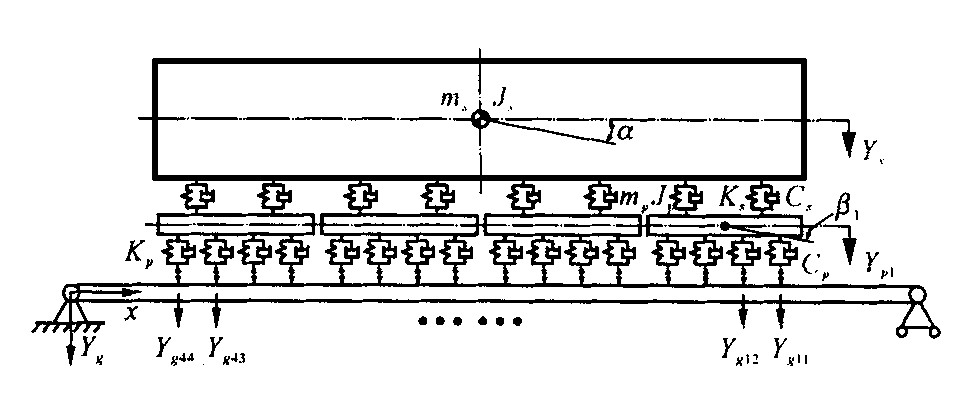On the Comparison of Dynamic Effects on Bridges of Maglev Trains with High-Speed Wheel/Rail Trains
Article Text (Baidu Translation)
-
摘要: 以德国Transrapid高速磁浮列车和日本新干线高速列车为基础, 通过建立高速磁浮、轮轨列车与线桥动态相互作用模型, 计算了不同行车速度(100~ 500 km/h) 和不同桥跨(12~ 32 m) 情形下高速列车与桥梁结构的动力响应, 并进行了细致的对比分析。结果表明: 磁浮列车在高速特别是超高速运行条件下的乘坐舒适性明显优于轮轨高速列车; 磁浮与轮轨高速列车作用于轨道的每延米荷载大体相当; 高速磁浮列车对小跨度(22 m以下) 桥梁的动力作用小于轮轨高速列车, 而对中等跨度尤其是大跨度桥梁, 轮轨高速列车较高速磁浮列车具有明显的优越性Abstract: A maglev vehicle/girder interaction model and a dynamic model of wheel/rail train and bridge are established, based on the configuration of German high speed maglev system and Japanese Shinkansen system, respectively.Dynamic responses of high speed trains passing through a bridge have been calculated and compared for various running speeds and various spans of bridges.Numerical results show that the ride comfort of the maglev vehicle is much better than that of the wheel/rail vehicle, especially in the situation of extraordinary high speed operation, the dynamic effect on bridge of the maglev train is smaller than that of the wheel/rail train only when the span length of bridge is below 22 m, but for the bridge with middle and large spans the dynamic effect of the maglev train will be stronger than that of the wheel/rail train in high speed operations.
-
Key words:
- maglev train /
- high speed railway /
- high speed train /
- track /
- bridge /
- dynamic interaction /
- comparison
-
表 1 高速磁浮车辆TR06参数
参数名称 数值 车体质量/kg 29200 转向架质量/kg 8000 车体点头惯量/kg·m2 1.75×106 转向架点头惯量/kg·m2 1.2×104 二系悬挂总刚度(每车) /N·m-1 6.812×105 一系磁隙总刚度(每车) /N·m-1 1.18×108 二系悬挂总阻尼(每车) /Ns·m-1 8.46×104 一系磁隙总阻尼(每车) /Ns·m-1 2.15×106 二系悬挂间距/m 3.0 一系悬挂间距/m 1.5 车辆长度/m 25 车辆总重/t 61.2 表 2 高速轮轨车辆JR300参数
参数名称 数值 车体质量/kg 31994 构架质量/kg 3333 轮对质量/kg 1650 车体点头惯量/kg·m2 2.1×106 构架点头惯量/kg·m2 3200 二系悬挂刚度(半车) /N·m-1 8.0×105 一系悬挂刚度(每轴) /N·m-1 2.36×106 二系悬挂阻尼(半车) /Ns·m-1 1.0×105 一系悬挂阻尼(每轴) /Ns·m-1 8.0×104 车辆定距之半/m 8.75 固定轴距之半/m 1.25 车轮半径/m 0.43 车辆总重/t 45.26 表 3 桥梁参数
跨度/m 梁高/m 每延米重量/kN·m-1 二期恒载/kN·m-1 截面抗弯刚度/N·m-2 12 1.2 69.30 75.0 1.15×1010 16 1.6 79.51 75.0 2.4686×1010 20 2.0 76.72 76.25 4.7201×1010 24 2.4 87.59 75.0 7.4078×1010 32 3.0 119.08 75.0 1.5867×1011 注: 德国Emsland磁浮线路高架混凝土简支梁主跨24.858 m, 抗弯刚度2.456×1010 N/m2。 -
[1] 沈志云. 高速磁浮列车轨道的动力作用及其与轮轨高速铁路的比较[J]. 交通运输工程学报, 2001, (1): 1-6. doi: 10.3321/j.issn:1671-1637.2001.01.001 [2] MATSUURA A. Dynamic interaction between vehicle and girders in high-speed railways[J]. Quarterly Reports of the RTRI, 1974, 15(3): 133-136. [3] HILLIGE D. Dynamik von magnetbahnfahrwegen in betonbauweise[J]. Meβ ergebnisse und ihr einfluβ auf den entwurf, VDI-Berichte, Nr. 510, 1984. [4] 翟婉明. 车辆-轨道耦合动力学[M]. 北京: 中国铁道出版社, 1997. [5] 刘华清. 德国磁悬浮列车Transrapid[M]. 成都: 电子科技大学出版社, 1995. [6] JENKINS H H. The effect of track and vehicle parameters on wheel/rail vertical dynamic forces[J]. Railway Engineering Journal, 1974, 3(1): 2-16. [7] SINHA P K. Electromagnetic suspension dynamics & control[M]. London: Perter Peregrinus Ltd, 1987. [8] CAI Y, CHEN S S, ROTE D M. Dynamics and controls in maglev systems[R]. Agronne National Laboratory Report ANL, 92/43. [9] CAI Y, CHEN S S. Dynamic characteristic of magnetically-levitated vehicle systems[J]. Applied Mechanics Reviews, 1997, 50: 647-670. doi: 10.1115/1.3101676 -





 下载:
下载:













